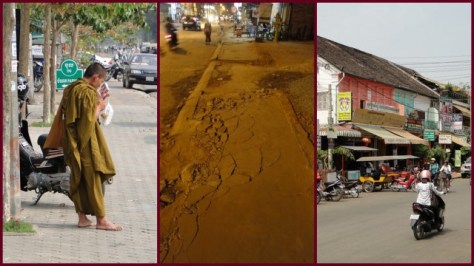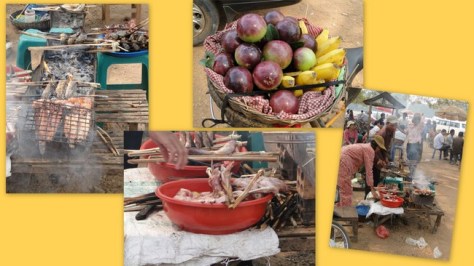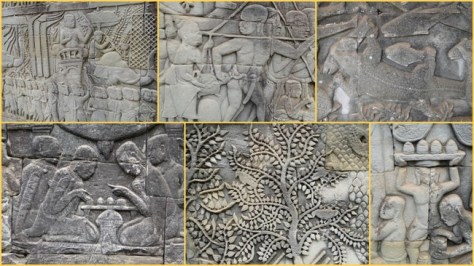
The ceiling fan stirs the languid air as mosquitoes flirt in the shadows of verdant ferns and orchids. Roosters compete with motor bikes to break the dawn. The gray/pink haze illuminates the dust laden street with its fading blue and red tin roofed houses. A young man in his 20’s, shirtless, in red shorts, barefoot, opens a creaking gate to drag the motor bike out of the night-time safety of his house. He pauses, takes in the day – a day just like yesterday – the sun will break through and life will steam.
 I sit on the rattan chair at the small dining table, close to the window away from the fluorescent ceiling lights and their harsh pools of blue/white light. The coffee is black, thick and sweetened with condensed milk, just as everyone in this ancient kingdom likes it – except me.
I sit on the rattan chair at the small dining table, close to the window away from the fluorescent ceiling lights and their harsh pools of blue/white light. The coffee is black, thick and sweetened with condensed milk, just as everyone in this ancient kingdom likes it – except me.
Other guests filter down the wide wooden staircase during the morning. Given the heat, humidity and sugar high from the coffee, I easily imagine a veritable cornucopia of characters from any number of 20th century expat-in-the-tropics novels. The fit German couple in the corner table – early 50’s but have that trekkers’ older look – bussed it overnight from the capital, 12 hours, no air-conditioning. I’ve been warned the overnight busses are not wise – theft, bandits, drivers falling asleep, other accidents. Relaxed they were with their pineapple juice, coffee and toast; they’ve faced worst dangers (?). There’s the eager well-scrubbed English 20-something travel companions planning their one-day schedule to see 14 temples, naive to the toll the jungle will take by temple # 3. The sullen early middle-aged North American couple, skin already too red from the sun, start the day badly due to the eggs (they were oddly undercooked in some sort of fat and sprinkled with ground cinnamon). Yet even though $20/night is nothing to spend on a hotel – ok, weak a/c, weaker WiFi and it’s the third world – it should include… Perhaps he needs to ask the Ta Prohm Strangler what life in the jungle should include.

Siem Reap, Cambodia, is not far from the 19th century. Just outside the town are dusty small villages still in that time warp. French annexation of the Angkor Wat region over a century ago assured its discovery as one of Earth’s great man-made sites, and Siem Reap developed a modest tourist industry. A few elegant hotels, such as the 1929 Grand Hotel d’Ankor, guest houses and a very modest Royal Residence were sprinkled on tree-lined streets in what was just a large village.

 The survival of Angkor, and Siem Reap, through World War II, the French Indochina War, the Vietnam War, Pol Pot and the civil war (total war years: 1939 -1989) is miraculous although like all urban areas, the town and its population suffered greatly. Yet what is Siem Reap without Angkor, what is Angkor without the Khmer Empire, and what is empire without war?
The survival of Angkor, and Siem Reap, through World War II, the French Indochina War, the Vietnam War, Pol Pot and the civil war (total war years: 1939 -1989) is miraculous although like all urban areas, the town and its population suffered greatly. Yet what is Siem Reap without Angkor, what is Angkor without the Khmer Empire, and what is empire without war?

The meters of bas-relief carved on many walls of the over 200 temple complexes at Angkor Thom tell the story that this was the center of an empire – political, military, economic and religious – as well as the home to thousands of people for hundreds of years. Since 1989, stability under the restored monarchy has made tourism safe again at Angkor. Still, visiting the UNESCO site at night is neither allowed nor advisable. Driving, or even being driven, at night for any long distance in rural areas outside Siem Reap is not a good idea. Bus travel to the Lao border a couple hundred miles north can take a full day. It has been this way for hundreds of years, ever since the Khmer Empire moved its capital south and the Ta Prohm Strangler moved in.

The expansionist Thais of Siam put an end to the westward growth of the Khmers in the 15th century by sacking and eventually occupying most of the Empire’s capital at Angkor Thom. Then the French took it from the Thais (1907) and gave it back to the new Khmer kingdom of Cambodia (under their “protection”). Except there’s still this issue over the 11th century Preah Vihear temple right on the border created after the French annexed the land so…

Siem Reap exploded during the last decade developing from a modest town into a chaotic jumble of village/tacky/new high-end without sufficient infrastructure. A new strip of luxury resort hotels, lining the road from the airport to town, seriously serving bus tours, seem incongruous interspersed with rice paddies and no beach. The old French Quarter’s charm is hidden behind questionable electrical lines and examples of exuberant marketing.
Dusty unpaved roads with small houses and even smaller tailor shops, fruit stands and tall narrow guest houses intersect with a boulevard and the ATM across the street. The night-time scene is classic: locals hawking cheap wares while children watch TV on someone’s laptop, “tuk-tuk? where are you going?” the smells of grilled meat and humid air, music thumping from dozens of open bar/restaurants, “2 dollars foot message?” lights of all shapes and colors illuminating a kaleidoscope of swirling Australians, French and Japanese dodging the motor bikes and tuk-tuks. The gods and demons of ancient Angkor would prefer if Siem Reap was grander, but I’m confident they’d approve the activity – after all, it is once again Cambodia’s cash cow. Could the Strangler be failing?

Creating a sustainable economy is difficult in a region both exhausted by strife and whose fame is based on ruins. Artisans d’Angkor operates both training facilities and retail outlets for high-end traditional Khmer silk, wood and stone arts and crafts. Training those with special physical needs is part of their mission as well. Touring both the craft shops and the silk farm is instructive and a pleasant break from tracking down the Ta Prohm Strangler.

Southeast Asians eat all the time – a grilled banana, nibble fresh pineapple, sip some cane juice, a fresh baked fish in salt, a coke, a few dried strawberries. There’s always food, and no one’s fat. Yet KFC’s here and Australian beef burgers but so are frog’s legs and sautéed freshly picked morning glory greens from the river bank.


There’s a quiet side, the banks of the Siem Reap River. The town’s best restaurant and small hotel, Bopha, is located at 512 Acharsva Street facing the east bank. It’s a haven of calm with rooms and the restaurant surrounding and within several lush tropical garden courtyards. A private pool adds to the relaxation of spending less than $US60/double and US$20/couple for haute Khmer cuisine (US$10-20/wine).

 The lure is still the past – the Royal City of Angkor Thom, the vast complex of 243 temple cities once populated with over one million people ruling an empire covering much of present day Southeast Asia. Started by Khmer kings and Hindu priests in the 9th century, reaching its zenith in the 13th as the capital of a Buddhist empire, sacked by the Thais in the 15th century, it has been sustained and ultimately saved by monks from the strangulation of neglect, changing politics, wars and the jungle.
The lure is still the past – the Royal City of Angkor Thom, the vast complex of 243 temple cities once populated with over one million people ruling an empire covering much of present day Southeast Asia. Started by Khmer kings and Hindu priests in the 9th century, reaching its zenith in the 13th as the capital of a Buddhist empire, sacked by the Thais in the 15th century, it has been sustained and ultimately saved by monks from the strangulation of neglect, changing politics, wars and the jungle.

The Strangler Fig (strangler vine to the locals) sends dozens of roots deep into the ground around rocks and buildings for hundreds of feet. It encases and crushes whatever it encounters. To kill the vine, all roots must be severed. To restore a temple, the vines must be killed.
A metaphor for the restored Khmer Kingdom of Cambodia? Can all the destructive roots of the past 500 years be severed and the orderly, yet bloody, grandeur of nationhood be reborn? Or will Siem Reap be a new Khmer model: play it day-by-day, see what happens, hope, sweat and keep the Ta Prohm Strangler at bay.





When you said that Southeast Asians eat all the time, it is true! A friend of mine, who is German, was visiting Indonesia a few years ago and he always got food from everyone, all the time!
By the way, nice montages!
Thank you Bama…and the food is so good!!!
Great post. Although I haven’t been to Siem Reap and Angkor in about five years, I still think it is one of the greatest countries, areas, monuments and wonder of the world. Love the Phsar Chas shots. I think I spent a whole day in there.
John